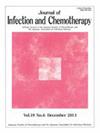Ban of colistin livestock feed supplementation decreased the prevalence of colistin-resistant Escherichia coli in Ecuador
IF 1.9
4区 医学
Q3 INFECTIOUS DISEASES
引用次数: 0
Abstract
Objectives
In 2019, Ecuador implemented a ban on colistin feed supplementation owing to the increasing prevalence of colistin-resistant bacteria; however, the impact of this ban remains unclear.
Methods
In this study, we aimed to elucidate the effects of the 2019 colistin ban by comparing the prevalence of colistin-resistant Escherichia coli in Ecuador with that in Vietnam, where colistin use is still permitted. We isolated colistin-resistant E. coli from the fecal samples of residents and detected mobile colistin resistance (mcr) genes in both the fecal samples and isolates.
Results
Prevalence of colistin-resistant E. coli significantly decreased from 80.6 % in 2019 (n = 139) to 4.7 % in 2022 (n = 106) in Ecuador. Meanwhile, colistin-resistant E. coli prevalence only decreased from 84.7 % in 2017 (n = 98) to 62 % in 2024 (n = 50) in Vietnam. Notably, 96.8 % of the colistin-resistant E. coli isolates in Vietnam carried the mcr genes in 2024, whereas only 4.7 % of the isolates in Ecuadorian fecal samples harbored these genes in 2023.
Conclusions
Overall, our findings highlight the significant impact of colistin use regulations on the decreased prevalence of colistin-resistant E. coli among Ecuadorian residents.
禁止在牲畜饲料中添加粘菌素降低了厄瓜多尔耐粘菌素大肠杆菌的流行率。
目标:2019年,由于耐粘菌素细菌日益流行,厄瓜多尔实施了一项禁止添加粘菌素饲料的禁令;然而,这一禁令的影响尚不清楚。方法:在本研究中,我们旨在通过比较厄瓜多尔和越南耐粘菌素大肠杆菌的流行情况,阐明2019年粘菌素禁令的影响,越南仍允许使用粘菌素。我们从居民的粪便样本中分离出耐粘菌素的大肠杆菌,并在粪便样本和分离物中检测到移动粘菌素抗性(mcr)基因。结果:厄瓜多尔耐粘菌素大肠杆菌的患病率从2019年的80.6% (n = 139)显著下降至2022年的4.7% (n = 106)。与此同时,越南耐粘菌素大肠杆菌患病率仅从2017年的84.7% (n = 98)下降到2024年的62% (n = 50)。值得注意的是,2024年越南96.8%的耐粘菌素大肠杆菌分离株携带mcr基因,而2023年厄瓜多尔粪便样本中只有4.7%的分离株携带这些基因。结论:总的来说,我们的研究结果强调了粘菌素使用法规对厄瓜多尔居民中耐粘菌素大肠杆菌患病率降低的重大影响。
本文章由计算机程序翻译,如有差异,请以英文原文为准。
求助全文
约1分钟内获得全文
求助全文
来源期刊

Journal of Infection and Chemotherapy
INFECTIOUS DISEASES-PHARMACOLOGY & PHARMACY
CiteScore
4.10
自引率
4.50%
发文量
303
审稿时长
47 days
期刊介绍:
The Journal of Infection and Chemotherapy (JIC) — official journal of the Japanese Society of Chemotherapy and The Japanese Association for Infectious Diseases — welcomes original papers, laboratory or clinical, as well as case reports, notes, committee reports, surveillance and guidelines from all parts of the world on all aspects of chemotherapy, covering the pathogenesis, diagnosis, treatment, and control of infection, including treatment with anticancer drugs. Experimental studies on animal models and pharmacokinetics, and reports on epidemiology and clinical trials are particularly welcome.
 求助内容:
求助内容: 应助结果提醒方式:
应助结果提醒方式:


